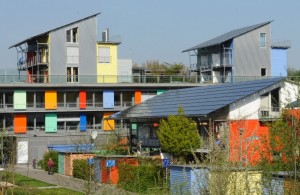PhotoVoltaic update
I attended a “German Photovoltaic Conference in NJ last week. When I get a link to the presentations I will add that here. [Update: here is the link]
In the meantime here are some items that caught my attention.
1. Philosophy
First, in a philosophical mood I was surprised that it was the American speakers at the conference who stressed climate change,problems with oil and coal, and the political system that made change almost impossible. By contrast the Germans were technical, neutral, practical — maybe just polite to their hosts?
It was an American who pointed us to the Kurt Vonnegut quote: “We probably could have saved ourselves, but we were too damned lazy to try very hard … and too damn cheap.” (Vonnegut suggested carving these words into a wall on the Grand Canyon, as a message from our extinct species to alien visitors.)
2. The German PhotoVoltaic story
Germany is way ahead of any other nation in terms of installed PV capacity – and had a record year of additional installations in 2009. They expect some drop off after June this year because feed-in tariffs are being reduced by 9% as part of a long term plan to make the industry self sufficient.
As a share of the world-wide PV market Germany has 53%, compared to the US at 7% and even Czechoslovakia at 6%. Given that the US has 307 million people vs. Germany at 82, and that the total insolation for Germany is about equal to that of Alaska there is clearly some imbalance. The US market should be about 30 times larger to be comparable.
Why does Germany have such a large PV market?
- Customers there are willing to pay more for electricity. Some 70% agree that the benefits are worth the extra expense. Call it good education, propaganda, or whatever, it gets results.
- Anyone installing PV is guaranteed a feed-in rate about double the retail cost of electricity provided by the suppliers (about 40 euro cents feed-in(currently) vs 20 euro cents residential supply . That rate is guaranteed for 20 years. At the end of that time the PV system is well and truly paid for. Worst case, even if the power company will not buy any, at any price, the consumer still has free power coming into their home or business. The average increase to the consumer on their electricity bill is about 5%.
- My math doesn’t work out; If all of that increase is due to the high feed-in tariff it would suggest that some 5% of consumed electricity is from PV. The actual number is much lower than that – some 1.1% of “renewable” power is from PV, or 0.6% of total electricity from solar.
- This article in Spiegel Online paints a much grimmer picture of the situation. The reader is cautioned to take the political stance of the magazine into account while reading…
- The New York Times reviews the situation as well.
- The government regulates and mandates the feed-in tariff but does NOT subsidize it. The consumer pays.
The results:
- The massive installed base above
- Experience in doing it – and now trying to export that expertise. Hence this conference to publicize the capabilities and look for partners.
- A drop in the cost of PV by 57% between 2006 and 2010
- Some 60,000 jobs in PV manufacture, installation and maintenance
Lessons:
- The model works: Create Demand – Build and Install the Product – Become Cost Competitive – Create a Self Sufficient Industry
- Don’t rely on government subsidies. They become too tempting a target for cutting when economic times get tough.
3. Some Megatrends
- The community will turn green and demand renewable energy, eventually rising to 100%
- The smart grid will get really smart, and include such things as integrated energy storage in electric vehicles.
- [To digress for a moment – the realist worked on electronic medical records 30(!) years ago. His younger self would not believe that we would still be struggling with the same problem today. So I will accept the “smart grid” as a trend – without a time-line]
- Power Plant Solutions will become integrated, with an extensive Information Technology component.
- Consumers will be offered integrated energy solutions – including water
- Transport will become increasingly solar (i.e. electric/hydrogen) oriented.
- [The realist would like to add school buses to the list of ideal vehicles to be electric powered. They get used for a few hours a day, typically cover short distances, and sit in parking lots all night and on weekends. A second factor is that children might appreciate a quiet, modern bus. I can see why American adults don’t much like public transport; they remember the noisy, smelly, uncomfortable school bus, and don’t ever want to ride on anything like that if they can help it…]
- Solar installations will be offered as routine systems by builders, HVAC contractors, roofers, electricians, plumbers etc.
All in all a good conference with lots of stuff to think about, and a lot of hurdles ahead.
[Again, here is the link to the German-American Chamber of Commerce and the conference agenda with the presentations.]
Posted: May 25th, 2010 under Uncategorized.


Leave a Reply
You must be logged in to post a comment.